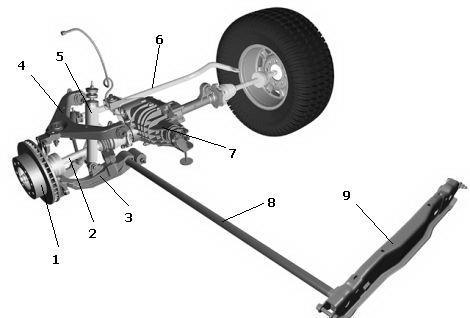
A modern car is a technically sophisticated device. Almost every node has several varieties, sometimes fundamentally different in functionality. Especially this is about the car suspension. Consider one of the types of suspension. Device
Device
The work items of this type of suspension are torsion-rods and are used as elastic item of suspension. They are circular or square section, and are rarely used plate-plate-collected from several plates. They are generally made of alloy steel.
In our time, the type of rear wheel suspension is relatively large. In this case the wheels are connected to the rolling beam. In such a suspension, the main elastic element remains the springs, not the peat, which is used as a supporting element, which can increase the level of comfort in the car.

History
For the first time, a suspension of this type was established at the Citroen Traction Avant in 1934, almost simultaneously with the start of the German Volkswagen Beetle with a similar peat suspension. But the French were the first to be. In the years of war, the torsion suspension was actively used in armored vehicles. It was equipped with most German and some Soviet tanks, including the famous KV-1 and Pz. V "Panther". In the post-war years, torcions were used by many European automakers. In 1961, the revolutionary Jaguar E-Type was first used as a front suspension. The US automakers were not behind the European-torcions installed on Chrysler and Packard vehicles. In the Soviet Union, the torsion suspension was used in the ZL and LuAZ cars. Such suspension, taken from the Volkswagen Beetle, was also equipped with the famous Zaporozhets.

A semi-dependent torsion suspension was developed by Audi in the 1970s. This suspension of the suspension is used today, mainly in the budget and front-wheel-drive vehicles. Advantages and disadvantages
Advantages and disadvantages
The Torsion suspension is much smaller than the spring, it is easier to install, it weighs less. It also makes it much easier and faster to adjust the car's light without any special manipulation or replacement of the suspension parts. In terms of controllability, the hovering suspension is much better driven by a front-wheel drive vehicle with it unlikely to lift the back "leg" in a sharp and fast turn. There are a few drawbacks. Vehicles equipped with a torsion suspension are suffering from oversteer (a part of the "Zaporozhtzi" problem is a spread in not the most cool turns, at not the highest speeds). In addition, the maximum load on such suspension is low, and the use of expensive alloys is necessary for its manufacture.







